 |
OpenVMS/Hanzi RTL Chinese Screen Management (SMG$)
Manual
SMG$SELECT_FROM_MENU
The Make a Selection from the Menu routine lets you move between the
menu choices using the arrow keys and lets you make a selection by
pressing the Return key.
Format
SMG$SELECT_FROM_MENU keyboard-id ,display-id ,selected-choice-number
[,default-choice-number] [,flags] [,help-library] [,timeout]
[,word-terminator-code] [,selected-choice-string] [,rendition-set]
[,rendition-complement]
RETURNS
| OpenVMS usage |
cond_value |
| type |
longword (unsigned) |
| access |
write only |
| mechanism |
by value |
Arguments
keyboard-id
| OpenVMS usage |
identifier |
| type |
longword (unsigned) |
| access |
read only |
| mechanism |
by reference |
Identifier of the virtual keyboard from which the terminal user's
responses are read. The keyboard-id argument is the
address of an unsigned longword containing this identifier.
display-id
| OpenVMS usage |
identifier |
| type |
longword (unsigned) |
| access |
read only |
| mechanism |
by reference |
Identifier of the virtual display in which the choices are displayed.
The display-id argument is the address of an unsigned
longword containing this display identifier. This virtual display must
be pasted to a pasteboard and cannot be batched or occluded.
selected-choice-number
| OpenVMS usage |
word_unsigned |
| type |
word (unsigned) |
| access |
write only |
| mechanism |
by reference |
Identification number of the menu item selected. The
selected-choice-number argument is the address of an
unsigned word that receives this number. The
selected-choice-number corresponds to the index of the
menu item in the static string array specified in SMG$CREATE_MENU.
default-choice-number
| OpenVMS usage |
word_unsigned |
| type |
word (unsigned) |
| access |
read only |
| mechanism |
by reference |
Optional identification number of the default menu item. The
default-choice-number argument is the address of an
unsigned word that contains the number of the default menu item. The
default-choice-number corresponds to the index of the
default menu item in the static string array specified in
SMG$CREATE_MENU. If omitted, the default choice will be the last menu
item already selected, or the first item in the menu if no selections
have yet been made.
flags
| OpenVMS usage |
mask_longword |
| type |
longword (unsigned) |
| access |
read only |
| mechanism |
by reference |
Optional bit mask indicating behavior when a selection is made. The
flags argument is the address of an unsigned longword
containing the flag. Valid values are as follows:
|
SMG$M_RETURN_IMMED
|
Returns control to the user when any key other than an arrow key is
entered.
|
|
SMG$M_REMOVE_ITEM
|
Causes SMG$SELECT_FROM_MENU to allow each menu item to be selected only
once.
|
help-library
| OpenVMS usage |
char_string |
| type |
character string |
| access |
read only |
| mechanism |
by descriptor |
Optional help library to use if the PF2/HELP key is pressed. The
help-library argument is the address of a descriptor
pointing to this help library name. Note that this argument is ignored
if flags specifies SMG$M_RETURN_IMMED. The default is
SYS$HELP:HELPLIB.HLB.
If the menu item does not consist of ASCII characters, the menu item is
not used to get the help text but just invokes help facility to specify
the help topic to get some information.
timeout
| OpenVMS usage |
longword_signed |
| type |
longword (signed) |
| access |
read only |
| mechanism |
by reference |
Optional timeout value. The timeout argument is the
address of a signed longword that specifies the number of seconds to
wait for a selection to be made.
word-terminator-code
| OpenVMS usage |
word_unsigned |
| type |
word (unsigned) |
| access |
write only |
| mechanism |
by reference |
Optional unsigned word that receives the code indicating which key
terminated the read. The word-terminator-code argument
is the address of an unsigned word that receives this terminating key
code.
selected-choice-string
| OpenVMS usage |
char_string |
| type |
character string |
| access |
write only |
| mechanism |
by descriptor |
Optional string that receives the text of the menu item selected. The
selected-choice-string is the address of a descriptor
pointing to this string.
rendition-set
| OpenVMS usage |
mask_longword |
| type |
longword (unsigned) |
| access |
read only |
| mechanism |
by reference |
Attribute specifier. The optional rendition-set
argument is the address of a longword bit mask in which each attribute
set causes the corresponding attribute to be set in the display. The
following attributes can be specified using the
rendition-set argument:
|
SMG$M_BLINK
|
Displays blinking characters.
|
|
SMG$M_BOLD
|
Displays characters in higher-than-normal intensity.
|
|
SMG$M_REVERSE
|
Displays characters in reverse video; that is, using the opposite of
the default rendition of the virtual display.
|
|
SMG$M_UNDERLINE
|
Displays underlined characters.
|
SMG$M_USER1 through
SMG$M_USER8
|
Displays user-defined attributes.
|
The display-id argument must be specified when you use
the rendition-set argument.
rendition-complement
| OpenVMS usage |
mask_longword |
| type |
longword (unsigned) |
| access |
read only |
| mechanism |
by reference |
Attribute complement specifier. The optional
rendition-complement argument is the address of a
longword bit mask in which each attribute set causes the corresponding
attribute to be complemented in the display. All attributes that can be
specified with the rendition-set argument can be
complemented with the rendition-complement argument.
The display-id argument must be specified when you use
the rendition-complement argument.
The optional arguments rendition-set and
rendition-complement let the user control the
attributes of the virtual display. The rendition-set
argument sets certain virtual display attributes, while
rendition-complement complements these attributes. If
the same bit is specified in both the rendition-set
and rendition-complement parameters,
rendition-set is evaluated first, followed by
rendition-complement. By using these two parameters
together, the user can control each virtual display attribute in a
single procedure call. On a single-attribute basis, the user can cause
the following transformations:
| Set |
Complement |
Action |
|
0
|
0
|
Attribute set to default
|
|
1
|
0
|
Attribute on
|
|
0
|
1
|
Attribute set to complement of default setting
|
|
1
|
1
|
Attribute off
|
Description
SMG$SELECT_FROM_MENU lets you make a selection from the items in the
menu. Note that the routine SMG$CREATE_MENU must be called before
calling SMG$SELECT_FROM_MENU.
You can move between the various menu items using the arrow keys, and
you make a selection by pressing the Return key. Typing a Ctrl/Z
selects the current choice and returns the value SMG$_EOF. Note that if
there are more menu choices than can be displayed, the display is
scrolled, the appropriate arrow key is typed, and the additional menu
choices become visible.
The current selection is indicated in reverse video (or in the
rendition specified) and by the physical cursor. The selected choice is
returned to the caller in the selected-choice-number
argument. In addition, the selected item will be removed from the
remaining menu items if SMG$M_REMOVE_ITEM is specified for the
flags parameter.
SMG$SELECT_FROM_MENU has two modes of operation that are specified
using the flags argument. A value without
SMG$M_RETURN_IMMED (the default) causes the following behavior:
- The user can move among the choices using the arrow keys.
- The only keys that select the current item are the following:
Return
DO
SELECT
Enter
- HELP or PF2 outputs help for the current item.
- Ctrl/W refreshes the screen by calling SMG$REPAINT_SCREEN.
- Ctrl/Z selects the current item and returns a value of SMG$_EOF.
- PF1/UP_ARROW selects the first item in the menu.
- PF1/DOWN_ARROW selects the last item in the menu.
- PF1/LEFT_ARROW selects the first item in the current row.
- PF1/RIGHT_ARROW selects the last item in the current row.
- All other keys are ignored.
A value of SMG$M_RETURN_IMMED enables the following:
- The user can move among the menu choices using the arrow keys.
- Ctrl/Z selects the current item and returns SMG$_EOF.
- Any other key entered selects the current item.
In either case, the following key substitutions can be made:
- The LF key can be used in place of Down Arrow.
- The BACKSPACE key can be used in place of Left Arrow.
- The TAB key can be used in place of Right Arrow.
The SMG$K_TRM_keyname code for the terminating key is returned in the
optional word-terminator-code argument. Multiword menu
items are allowed.
When the menu items are not ASCII characters, the user can not display
the help text for the menu items by the PF2/HELP key, but just invoke
the help facility.
Condition Values Returned
|
SS$_NORMAL
|
Normal successful completion.
|
|
SMG$_EOF
|
End of file.
|
|
SMG$_NOTPASTED
|
The virtual display is not pasted.
|
|
SMG$_INVDIS_ID
|
The
display-id is invalid, does not contain a menu, or
contains a viewport.
|
|
SMG$_ILLBATFNC
|
The virtual display or pasteboard is batched.
|
|
SMG$_INVARG
|
Invalid argument or none of the menu items is selectable.
|
|
LIB$_xxxx
|
Any completion status returned by LIB$SCOPY.
|
|
SMG$_xxxx
|
Any completion status returned by
SMG$CHANGE_RENDITION, SMG$SET_CURSOR_ABS,
SMG$BEGIN_DISPLAY_UPDATE, SMG$END_DISPLAY_UPDATE, SMG$READ_KEYSTROKE,
SMG$PUT_HELP_TEXT, SMG$SAVE_PHYSICAL_SCREEN, or
SMG$RESTORE_PHYSICAL_SCREEN.
|
Examples
| #1 |
! +
! This VAX Pascal program demonstrates the use of SMG$CREATE_MENU and
! SMG$SELECT_FROM_MENU. This program creates a block menu
! and allows the user to make selections from the menu.
! -
[INHERIT ('SYS$LIBRARY:STARLET')]
PROGRAM BLOCK_MENU (INPUT,OUTPUT);
CONST
NULL = 0;
TYPE
CHAR_STRING = VARYING [20] OF CHAR;
WORD = [WORD] 0..65535;
FIXED_STRING = PACKED ARRAY[1..9] OF CHAR;
VAR
OPTIONS : ARRAY[1..9] OF FIXED_STRING;
I : INTEGER;
RET_STATUS : UNSIGNED;
SELECTED : FIXED_STRING;
NUMBER, DEF_NUMBER : WORD;
PB_ID, KB_ID, DISPLAY1, DISPLAY2 : UNSIGNED;
TERM : WORD;
[EXTERNAL] FUNCTION SMG$CREATE_PASTEBOARD(
VAR PASTEBOARD_ID : UNSIGNED
) : INTEGER; EXTERN;
[EXTERNAL] FUNCTION SMG$CREATE_VIRTUAL_KEYBOARD(
VAR KEYBOARD_ID : UNSIGNED
) : INTEGER; EXTERN;
[EXTERNAL] FUNCTION SMG$CREATE_VIRTUAL_DISPLAY(
NUM_ROWS : INTEGER;
NUM_COLS : INTEGER;
VAR DISPLAY_ID : UNSIGNED;
ATTRIBUTES : UNSIGNED
) : INTEGER; EXTERN;
[EXTERNAL] FUNCTION SMG$PASTE_VIRTUAL_DISPLAY(
DISPLAY_ID : UNSIGNED;
PASTEBOARD_ID : UNSIGNED;
ROW : INTEGER;
COL : INTEGER
) : INTEGER; EXTERN;
[EXTERNAL] FUNCTION SMG$CREATE_MENU(
DISPLAY_ID : UNSIGNED;
CHOICES : ARRAY[A..B : INTEGER] OF FIXED_STRING;
MENU_TYPE : UNSIGNED;
MENU_FLAGS : UNSIGNED;
ROW : INTEGER := %IMMED 0;
REND_SET : UNSIGNED := %IMMED 0;
REND_COMP : UNSIGNED
) : INTEGER; EXTERN;
[EXTERNAL] FUNCTION SMG$SELECT_FROM_MENU(
KEYBOARD_ID : UNSIGNED;
DISPLAY_ID : UNSIGNED;
VAR SELEC_NUM : WORD;
DEFAULT_NUM : WORD;
MENU_FLAGS : UNSIGNED;
HELP_LIBR : CHAR_STRING := %IMMED 0;
TIMEOUT : INTEGER := %IMMED 0;
VAR TERM_CODE : WORD;
VAR SELEC_STR : FIXED_STRING
) : INTEGER; EXTERN;
[EXTERNAL] FUNCTION SMG$PUT_LINE(
DISPLAY_ID : UNSIGNED;
TEXT : CHAR_STRING
) : INTEGER; EXTERN;
[EXTERNAL] FUNCTION SMG$DELETE_MENU(
DISPLAY_ID : UNSIGNED
) : INTEGER; EXTERN;
[EXTERNAL] FUNCTION LIB$STOP(
CONDITION_STATUS : [IMMEDIATE,UNSAFE] UNSIGNED
) : INTEGER; EXTERN;
BEGIN
DEF_NUMBER := 5;
OPTIONS[1] := 'Northwest';
OPTIONS[2] := 'North ';
OPTIONS[3] := 'Northeast';
OPTIONS[4] := 'West ';
OPTIONS[5] := 'Equator ';
OPTIONS[6] := 'East ';
OPTIONS[7] := 'Southwest';
OPTIONS[8] := 'South ';
OPTIONS[9] := 'Southeast';
RET_STATUS := SMG$CREATE_PASTEBOARD (PB_ID);
IF NOT ODD(RET_STATUS)
THEN
LIB$STOP(RET_STATUS);
RET_STATUS := SMG$CREATE_VIRTUAL_KEYBOARD (KB_ID);
IF NOT ODD(RET_STATUS)
THEN
LIB$STOP(RET_STATUS);
RET_STATUS := SMG$CREATE_VIRTUAL_DISPLAY (3, 12, DISPLAY2, SMG$M_BORDER);
IF NOT ODD(RET_STATUS)
THEN
LIB$STOP(RET_STATUS);
RET_STATUS := SMG$CREATE_VIRTUAL_DISPLAY (6, 37, DISPLAY1, SMG$M_BORDER);
IF NOT ODD(RET_STATUS)
THEN
LIB$STOP(RET_STATUS);
RET_STATUS := SMG$PASTE_VIRTUAL_DISPLAY (DISPLAY2, PB_ID, 2, 16);
IF NOT ODD(RET_STATUS)
THEN
LIB$STOP(RET_STATUS);
RET_STATUS := SMG$PASTE_VIRTUAL_DISPLAY (DISPLAY1, PB_ID, 10, 10);
IF NOT ODD(RET_STATUS)
THEN
LIB$STOP(RET_STATUS);
RET_STATUS := SMG$CREATE_MENU (DISPLAY1, OPTIONS, SMG$K_BLOCK,
SMG$M_DOUBLE_SPACE,,, SMG$M_BOLD);
IF NOT ODD(RET_STATUS)
THEN
LIB$STOP(RET_STATUS);
RET_STATUS := SMG$SELECT_FROM_MENU (KB_ID, DISPLAY1, NUMBER, DEF_NUMBER,
SMG$M_RETURN_IMMED,,, TERM, %DESCR SELECTED);
IF NOT ODD(RET_STATUS)
THEN
LIB$STOP(RET_STATUS);
RET_STATUS := SMG$PUT_LINE (DISPLAY2, %DESCR SELECTED);
IF NOT ODD(RET_STATUS)
THEN
LIB$STOP(RET_STATUS);
END.
|
The output for this VAX Pascal program is shown in the following
figures. In Figure SMG-49, the program is waiting for the user to make
a menu selection.
Figure SMG-49 Output Generated Before a Menu Selection Is
Made
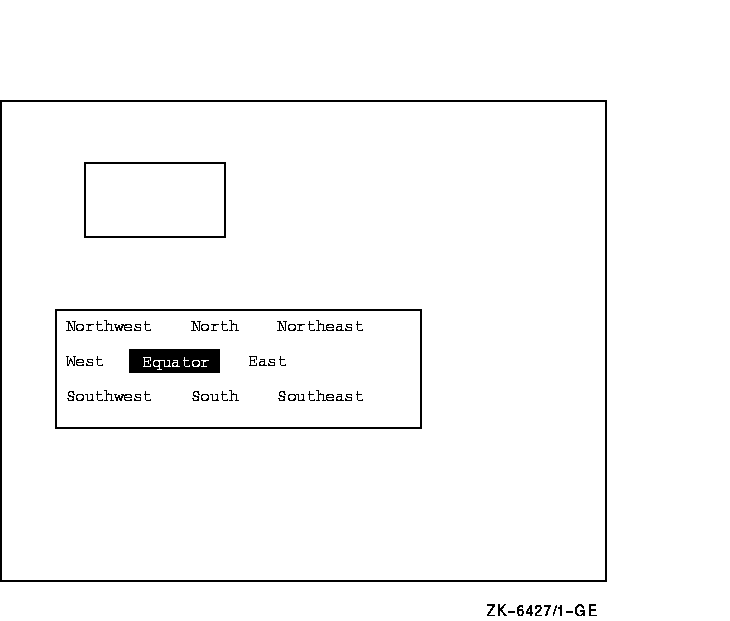
Because the menu is created using the SMG$M_RETURN_IMMED attribute,
once the user makes a selection the menu is terminated, and control
returns to the program. The menu item selected by the user is displayed
in the upper virtual display. This output is shown in Figure SMG-50.
Figure SMG-50 Output Generated After the User Selects an
Item
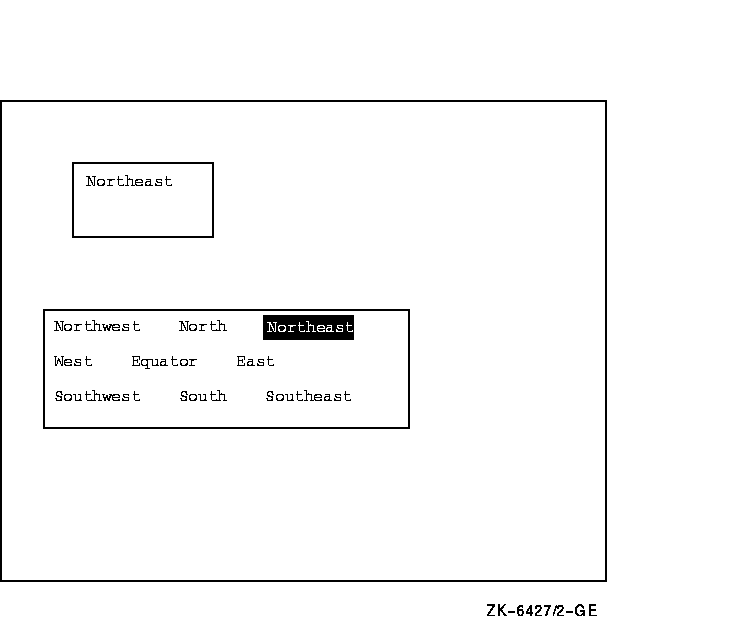
| #2 |
10 !+
!This VAX BASIC program demonstrates the use of
!SMG-supported menus. Using SMG$CREATE_MENU and
!SMG$SELECT_FROM_MENU, this program creates an
!application that uses a vertical menu and allows
!the user to make multiple selections.
!-
OPTION TYPE = EXPLICIT
EXTERNAL SUB LIB$STOP (LONG BY VALUE)
EXTERNAL LONG FUNCTION SMG$CREATE_PASTEBOARD (LONG)
EXTERNAL LONG FUNCTION SMG$CREATE_VIRTUAL_KEYBOARD (LONG)
EXTERNAL LONG FUNCTION SMG$CREATE_VIRTUAL_DISPLAY (LONG, LONG, &
LONG, LONG, LONG)
EXTERNAL LONG FUNCTION SMG$PASTE_VIRTUAL_DISPLAY (LONG, LONG, &
LONG, LONG)
EXTERNAL LONG FUNCTION SMG$CREATE_MENU (LONG, STRING DIM(), LONG, &
LONG, LONG, LONG, LONG)
EXTERNAL LONG FUNCTION SMG$SELECT_FROM_MENU (LONG, LONG, WORD, &
WORD, LONG, STRING, LONG, WORD, STRING)
EXTERNAL LONG FUNCTION SMG$PUT_LINE (LONG, STRING)
EXTERNAL LONG FUNCTION SMG$DELETE_MENU (LONG)
%INCLUDE "$SMGDEF" %FROM %LIBRARY "SYS$LIBRARY:BASIC$STARLET"
DECLARE STRING chosen
MAP (xyz) STRING choice(20) = 16
DECLARE LONG ret_status, pasteboard_id, display1_id, display2_id, &
keyboard_id
DECLARE WORD number
choice(0) = "ONE"
choice(1) = "TWO"
choice(2) = "THREE"
choice(3) = "FOUR"
choice(4) = "FIVE"
choice(5) = "SIX"
choice(6) = "SEVEN"
choice(7) = "EIGHT"
choice(8) = "NINE"
choice(9) = "TEN"
choice(10) = "ELEVEN"
choice(11) = "TWELVE"
choice(12) = "THIRTEEN"
choice(13) = "FOURTEEN"
choice(14) = "FIFTEEN"
choice(15) = "SIXTEEN"
choice(16) = "SEVENTEEN"
choice(17) = "EIGHTEEN"
choice(18) = "NINETEEN"
choice(19) = "TWENTY"
choice(20) = "Exit"
ret_status = SMG$CREATE_PASTEBOARD (pasteboard_id)
IF (ret_status AND 1%) = 0% THEN
CALL LIB$STOP (ret_status BY VALUE)
END IF
ret_status = SMG$CREATE_VIRTUAL_KEYBOARD (keyboard_id)
IF (ret_status AND 1%) = 0% THEN
CALL LIB$STOP (ret_status BY VALUE)
END IF
ret_status = SMG$CREATE_VIRTUAL_DISPLAY (10, 20, display1_id, &
SMG$M_BORDER, SMG$M_BOLD)
IF (ret_status AND 1%) = 0% THEN
CALL LIB$STOP (ret_status BY VALUE)
END IF
ret_status = SMG$CREATE_VIRTUAL_DISPLAY (6, 20, display2_id, &
SMG$M_BORDER,)
IF (ret_status AND 1%) = 0% THEN
CALL LIB$STOP (ret_status BY VALUE)
END IF
ret_status = SMG$PASTE_VIRTUAL_DISPLAY (display2_id, &
pasteboard_id, 17, 20)
IF (ret_status AND 1%) = 0% THEN
CALL LIB$STOP (ret_status BY VALUE)
END IF
ret_status = SMG$PASTE_VIRTUAL_DISPLAY (display1_id, &
pasteboard_id, 4, 20)
IF (ret_status AND 1%) = 0% THEN
CALL LIB$STOP (ret_status BY VALUE)
END IF
ret_status = SMG$CREATE_MENU (display1_id, choice(), &
SMG$K_VERTICAL,,,SMG$M_BOLD, SMG$M_BOLD)
IF (ret_status AND 1%) = 0% THEN
CALL LIB$STOP (ret_status BY VALUE)
END IF
20 ret_status = SMG$SELECT_FROM_MENU (keyboard_id, display1_id, &
number,, SMG$M_REMOVE_ITEM,,,,chosen)
IF (ret_status AND 1%) = 0% THEN
CALL LIB$STOP (ret_status BY VALUE)
END IF
ret_status = SMG$PUT_LINE (display2_id, chosen)
IF (ret_status AND 1%) = 0% THEN
CALL LIB$STOP (ret_status BY VALUE)
END IF
IF (number <> 20) THEN
GOTO 20
END IF
ret_status = SMG$DELETE_MENU (display1_id)
IF (ret_status AND 1%) = 0% THEN
CALL LIB$STOP (ret_status BY VALUE)
END IF
END
|
The vertical menu generated by this VAX BASIC program is shown in the
following figures. The default choice is set to the first item in the
menu: "ONE". In Figure SMG-51, the program is waiting for the
user to make a selection from the menu.
Figure SMG-51 Output Generated Before the User Selects a Menu
Item
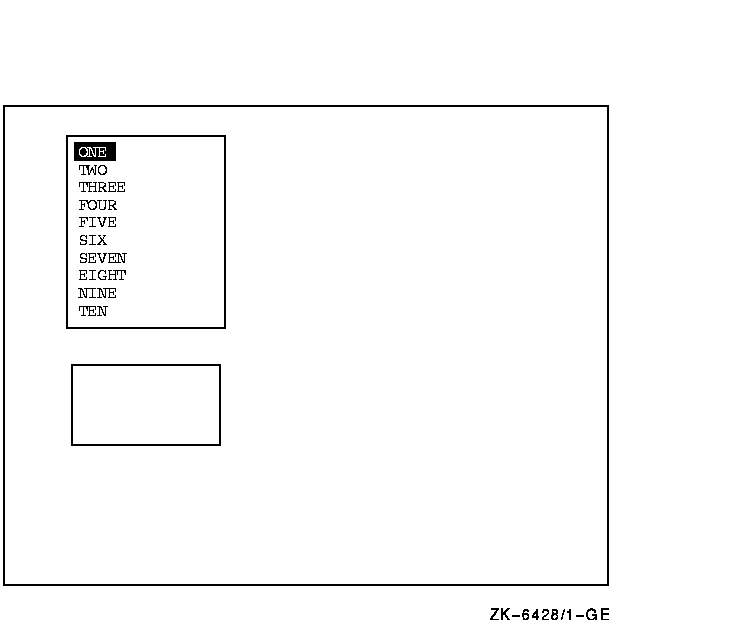
Because the menu was created with the SMG$M_REMOVE_ITEM attribute, the
user cannot reselect a particular menu item. However, unlike Example 1,
the user can make multiple selections. In Figure SMG-52, the user has
selected "SIX" and "THIRTEEN", and the program has
again highlighted the default menu item and is waiting for the user to
make another selection.
Figure SMG-52 Output Generated After Two Selections

In Figure SMG-53, the user has selected "EXIT" and the menu
has been deleted, although it still appears on the screen. At this
point, no more selections can be made.
Figure SMG-53 Output Generated After EXIT Is Selected

| #3 |
C+
C This DEC Fortran example program illustrates the use of
C SMG$CREATE_MENU, SMG$SELECT_FROM_MENU, and SMG$DELETE_MENU
C to create an application that lets a user make multiple
C selections from a horizontal menu.
C-
IMPLICIT INTEGER (A-Z)
INCLUDE '($SMGDEF)'
CHARACTER*20 c
CHARACTER*20 a(20) /'One','Two','Three','This is Four','Five',
1 'Six','Seven','Eight','Nine','I like ten',
2 'Eleven','Twelve','Thirteen','Fourteen',
3 'Fifteen','Sixteen','Seventeen','Eighteen',
4 'Nineteen','Exit this menu.' /
s = SMG$CREATE_PASTEBOARD(p_id)
if (.not. s) call LIB$SIGNAL(%VAL(s))
s = SMG$CREATE_VIRTUAL_KEYBOARD(k_id)
if (.not. s) call LIB$SIGNAL(%VAL(s))
s = SMG$CREATE_VIRTUAL_DISPLAY(6,50, d_id2, SMG$M_BORDER)
if (.not. s) call LIB$SIGNAL(%VAL(s))
s = SMG$CREATE_VIRTUAL_DISPLAY(6,50, d_id, SMG$M_BORDER)
if (.not. s) call LIB$SIGNAL(%VAL(s))
s = SMG$PASTE_VIRTUAL_DISPLAY(d_id2, p_id, 2,2)
if (.not. s) call LIB$SIGNAL(%VAL(s))
s = SMG$PASTE_VIRTUAL_DISPLAY(d_id, p_id, 10,2)
if (.not. s) call LIB$SIGNAL(%VAL(s))
s = SMG$CREATE_MENU(d_id,a,SMG$K_HORIZONTAL,,2,SMG$M_REVERSE)
if (.not. s) call LIB$SIGNAL(%VAL(s))
20 s = SMG$SELECT_FROM_MENU(k_id, d_id, n,6,,,,,C,SMG$M_BOLD,0)
if (.not. s) call LIB$SIGNAL(%VAL(s))
s = SMG$PUT_LINE(d_id2,c)
if (.not. s) call LIB$SIGNAL(%VAL(s))
if (n .ne. 20) goto 20
s = SMG$DELETE_MENU(d_id)
if (.not. s) call LIB$SIGNAL(%VAL(s))
END
|
The horizontal menu generated by this DEC Fortran example program is
shown in the following figures. In Figure SMG-54, the program displays
all menu items in reverse video except for the default choice. At this
point, the program is waiting for the user to make a selection.
Figure SMG-54 Output Generated Before a Menu Item Is
Selected

Because no attributes were specified when this menu was created, the
items in the menu can be "reselected". Figure SMG-55 shows
the screen image after the user has made three selections, two of which
are the same.
Figure SMG-55 Output Generated After Three Menu
Selections
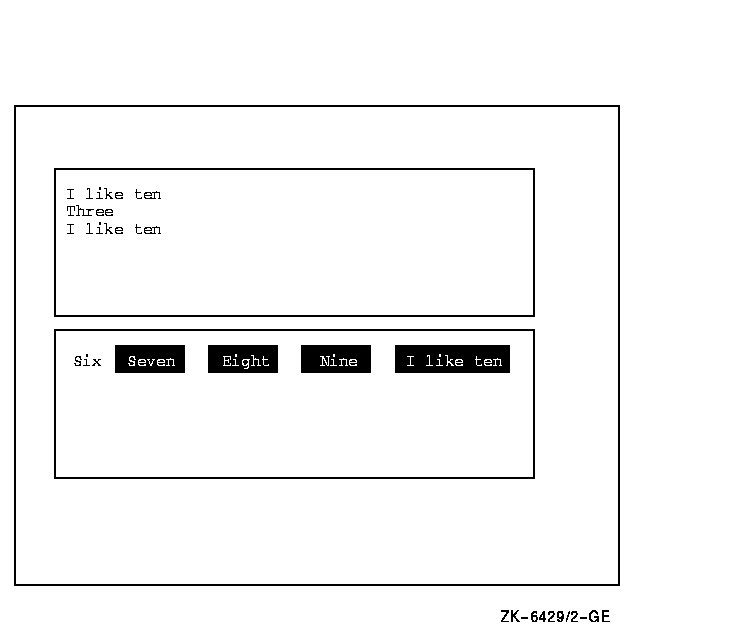
In Figure SMG-56, the user has selected "Exit this menu" and
the program has completed execution.
Figure SMG-56 Output Generated After Program Completion
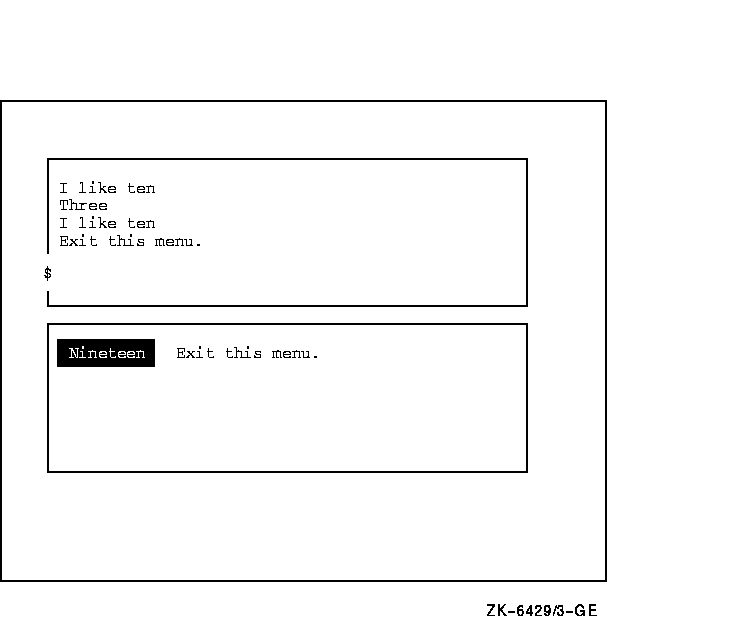
|







